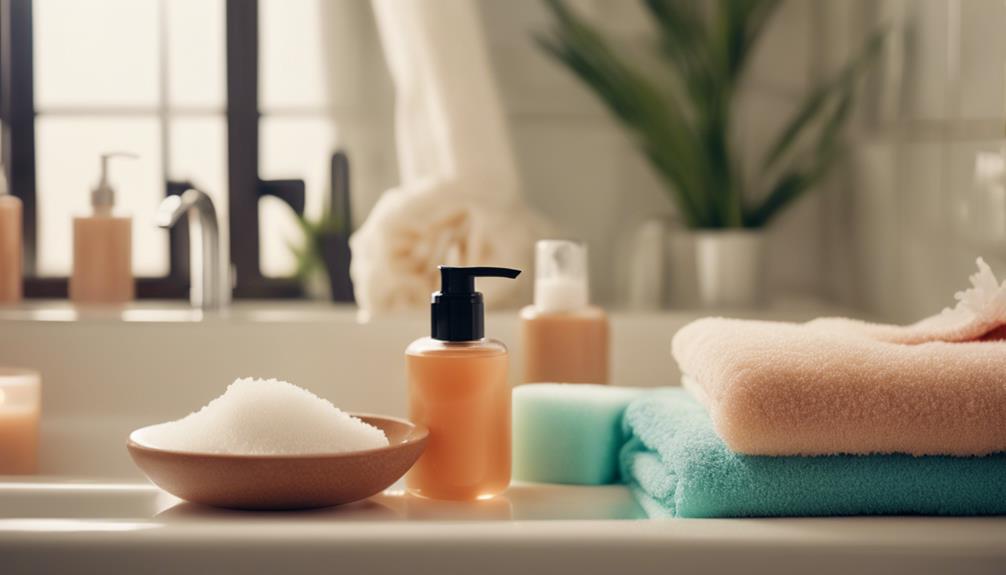If you are having difficulty achieving a tan on your chest, there could be several factors contributing to this issue. Your skin’s thickness and natural pigmentation can impact how evenly it tans. Certain areas, such as the collarbone, may struggle to darken consistently. It’s possible that you are not positioning yourself for optimal sun exposure or utilizing enough reflective surfaces. Inadequate nutrition, specifically a lack of vitamins A, D, or E, could also impede your tanning progress. Additionally, certain medications may heighten your skin’s sensitivity to sunlight, making it more challenging to achieve the desired glow. Stay tuned for tips on further enhancing your tanning experience.
Key Takeaways
- Thinner skin areas, like the chest, may tan unevenly due to natural pigmentation patterns and skin variations.
- Insufficient sun exposure or incorrect body positioning can lead to patchy tanning results on the chest.
- Uneven application of sunscreen can cause burns and hinder an even tan on the chest area.
- Nutritional deficiencies, particularly in vitamins A, D, and E, can negatively affect the skin's ability to tan.
Factors Affecting Tanning Results
Several key factors can greatly influence your tanning results, from skin thickness variations to the effectiveness of your tanning techniques.
Thicker skin, like that on your chest, tends to tan more slowly than thinner areas like your arms. Melanin concentration also plays a role, affecting how quickly your skin darkens. If you have delicate skin, such as on your collarbone, you might notice it struggles to tan effectively.
Additionally, natural pigmentation patterns can lead to uneven tanning. To improve your results, consider exfoliating before tanning and boosting your diet with beta-carotene-rich foods, which can support pigmentation from within.
Pay attention to these factors to enhance your tanning experience and achieve a more uniform glow.
Optimizing Sun Exposure Techniques
To achieve an even tan, positioning your body to capture direct sunlight at various angles is essential. Rotate your torso every 15-20 minutes to guarantee all areas, including your chest, receive adequate exposure.
Utilize reflective surfaces like water or sand to boost sunlight intensity on your skin. If you're tanning outdoors, try to find a spot with minimal obstructions, like trees or buildings.
Don't forget to apply sunscreen generously to protect your skin from harmful UV rays, even while tanning. Remember, the goal is to maximize your sun exposure while minimizing risks.
Experiment with different times of day, as morning or late afternoon sun can be less harsh and still effective for tanning.
Nutritional Impact on Tanning

Maximizing your tanning results goes beyond sun exposure; what you eat plays a significant role in how well your skin can develop a tan. Nutritional deficiencies, particularly in vitamins D, E, and A, can hinder your skin's ability to tan effectively.
Incorporating foods rich in these vitamins, like leafy greens, nuts, and fish, can enhance your skin's health. Don't forget about beta-carotene; foods like carrots and sweet potatoes can boost your pigmentation from within.
Omega-3 fatty acids are also essential for maintaining skin hydration, making your tan look more radiant. By ensuring a balanced diet, you're not just preparing your skin for the sun; you're setting the stage for a more vibrant, lasting tan.
Tanning Bed Limitations
Tanning beds can struggle to provide uniform color, often leaving areas like collarbones and hands with uneven tans. Freckles and skin variations can lead to patchy results, making it tough to achieve that desired glow. Additionally, overexposure can cause skin damage, increasing the risk of burns and long-term issues.
Here's a quick overview of common tanning bed limitations:
| Limitation | Description |
|---|---|
| Uneven Tanning | Areas with thinner skin tan less effectively. |
| Skin Sensitivity | Overexposure can lead to burns and irritation. |
| Patchy Results | Freckles absorb UV rays unevenly, causing spots. |
Being aware of these limitations can help you make better choices and minimize frustrating tanning experiences.
Medication Effects on Skin
Certain medications can heighten your skin's sensitivity to sunlight, making it harder to achieve an even tan. If you're on antibiotics, antihistamines, or certain acne medications, your skin may react differently to sun exposure.
This increased sensitivity can lead to sunburn or rashes, limiting your ability to tan effectively. You might find that even a short amount of sun exposure results in irritation, which isn't ideal when you're trying to enhance your chest tan.
To stay safe, use a broad-spectrum SPF, even on cloudy days, and consider consulting your healthcare provider before tanning. They can help you understand how your medications might affect your skin and offer advice tailored to your specific situation.
Skin Conditions and Tanning
Skin conditions like eczema and psoriasis can create challenges that lead to uneven tans on your chest and other areas. These issues can disrupt melanin production and affect how your skin responds to tanning.
To help you manage tanning with these skin conditions, consider these tips:
- Consult a Dermatologist: Get tailored advice for your specific skin condition.
- Moisturize Regularly: Keep your skin hydrated to promote an even tan.
- Patch Test Products: Before using self-tanners, check for reactions on a small area.
- Limit Sun Exposure: Protect sensitive areas with clothing or shade to prevent irritation.
Common Sunscreen Mistakes

When applying sunscreen, many people forget to cover all areas evenly, leading to patchy tans and sunburns.
It's essential to apply a generous amount, about an ounce for your entire body. Don't skip spots like the collarbone and underarms, as they're often neglected.
Also, remember to reapply every two hours, especially after swimming or sweating. Using a water-resistant formula can help, but it's not a substitute for regular reapplication.
Be cautious with spray sunscreens; they can leave areas unprotected if not applied thoroughly.
Finally, check the expiration date—expired sunscreen may not provide adequate protection.
Could Itchy Skin from Tanning Also Impact the Chest Area?
Yes, skin itching after tanning can also impact the chest area. The exposure to UV rays can cause dryness and irritation, leading to itchy skin. Using a moisturizer with aloe vera or calamine lotion can help soothe the itchiness. It’s important to stay hydrated and avoid excessive sun exposure to prevent further irritation.
Conclusion
In your quest for that perfect chest tan, understanding the various factors at play can make all the difference.
By optimizing your sun exposure techniques, addressing nutritional needs, and being aware of potential medication effects, you can overcome common pitfalls.
Remember, it's not just about soaking up the sun; it's about doing so wisely.
With a bit of strategy and patience, you'll be on your way to a sun-kissed glow that would make even Apollo envious.










